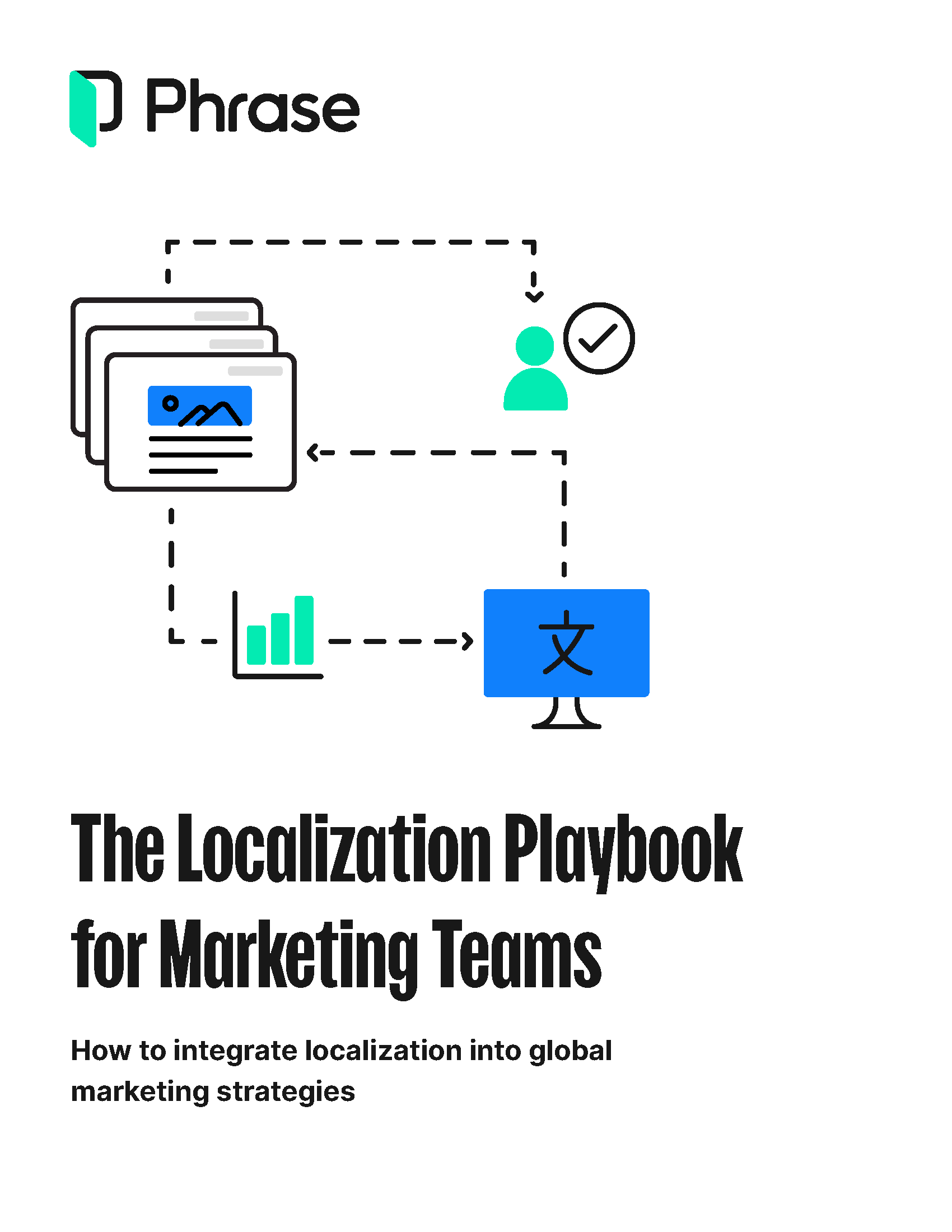Localization strategy
Content Localization: What It Is, and How to Make the Most of It

To succeed in going global, connecting with international audiences on an emotional level is key. It starts with communicating with potential customers in their native language and goes on with providing a personalized experience designed around local expectations, needs, and wants. This is where content localization comes in.
Be it web pages or marketing campaigns, adapting your content to the local context of your international audiences can make a big difference. It can help you gain trust, build relationships, promote customer satisfaction and loyalty, drive conversions and sales across markets, and ultimately, expand the global footprint of your business.
To break the language barrier and gain customers worldwide who will stick around to become true advocates of your product, you’ll need a solid content localization strategy and robust localization technology. Keep reading to find out how both can help you make the most of your content localization efforts.
What is content localization?
Content localization is the process of adapting content assets to the culture and language of customers in a target market. It goes beyond content translation, which is only one aspect of content localization.
Besides translating text from one language to another, content localization includes a significant cultural component. It’s a systematic way of considering as many aspects as possible when making content fit for a target audience in a specific market.
More specifically, content localization aims to adapt content of any form to locally accepted cultural norms that guide people’s behavior and interactions: style, register, images, symbols, colors, currency, date and time formats, and more.
In an ideal scenario, content localization also checks for potential double meaning, unintended connotations, or offensive expressions in slogans, names, jokes, and idioms, and finds brand-secure alternatives.
Why is content localization important?
Familiarity and a feeling of trustworthiness are of utmost importance when winning over new customers—and you can create these qualities by meeting your audience where they are: on their turf, in their language, and with content that resonates with them personally.
Studies have shown that localization can have a significant impact on business results. In fact:
- 40% will never buy from websites in other languages
- 65% prefer content in their language, even if it’s poor quality
- 73% want product reviews in their language
These findings make it clear that if you’re not localizing your content, you’re missing out on connecting with a large portion of global consumers. As a result, you could be losing out on valuable leads, conversions, and revenue.
When do you need content localization?
The simple answer is: As soon as you’re ready to launch in a new market. Entering foreign markets with non-localized content could not only result in missing out on conversion opportunities, but it could also take a toll on your business’s reputation. Potential customers who do find your content might not find that it resonates with them.
Even if localization follows a few months after launching, the damage might have already been done. That’s why it’s best to be proactive about it and have a plan in place from the start. This applies to even the seemingly least significant online campaigns—localize first, launch after, and avoid any potential embarrassment or cultural faux pas.
Once you’ve started operating in a new market, it’s important to keep up with changing trends and consumer needs by regularly monitoring your content. Localization isn’t a one-time event but rather an ongoing process that you’re better off integrating into your content strategy from the outset.
What are the benefits of content localization?
A good content localization strategy can help your company quickly get traction in a local market. A brand that’s able to speak its audience’s language and acknowledge its culture is telling them, “We get you, we care about you, and we want you to feel comfortable doing business with us.”
The main benefits of content localization include:
- Increased traffic and engagement: Driving traffic to your site is one thing, but getting people to stick around is another. By localizing your content, you can ensure that people not only find your site and click through to it, but that they also stay engaged once they land on your page.
- Higher credibility and conversions: A good localization strategy will help ensure that your site comes across as credible and that your audience feels confident purchasing from you.
- Lower marketing and advertising expenses: When done right, localization can help you avoid wasting money on marketing collateral that doesn’t resonate with your target audience—the upfront investment might be higher, but the derived savings will make it well worth your while in the long run.
- Improved search engine rankings: That culture influences search behavior isn’t news to anyone in the world of search engine optimization (SEO)—when you target the right keywords, adapt content to local consumption trends, and make your copy shine in the local language, your site is sure to rank higher in terms of international SEO.
- Competitive edge: Not all businesses localize content. This gives those that are willing to put in the extra effort a significant competitive edge to attract, convert, and retain customers in a given market.
- Greater customer loyalty and satisfaction: When customers feel valued, they’re likelier to remain loyal to a brand and continue doing business with it. Return customers are also easier and cheaper to market to, so it’s a win-win situation all around.
- Accelerated time to market: Localizing your content from day one with an efficient process and the right technology in place will help you get to market faster and avoid any last-minute rush jobs that can often lead to subpar results. We’ll expand on processes and tools later on.

FREE DOWNLOAD
Make global marketing strategies work in local markets
Harness the power of localization to effectively connect with audiences worldwide and discover best practices for making your next global marketing endeavor a success.
What are some types of content to consider for localization?
In multilingual content marketing, not all content formats are created equal—some types of content hold greater importance for localization than others. As a general rule, any type of content aimed at facilitating your operations in a specific market or intended to boost brand awareness, establish credibility, or drive conversions should be prioritized for localization.
Here are some common types of content that may need localization:
Legal content localization
If you’re expanding into a new market, you’ll most likely deal with different legal aspects: establishing entities, hiring, registering intellectual property, understanding tax structure, protecting data, and entering disputes are just a few legal processes that might look different than what you know—and there might be several more, completely unknown to you.
Linguists with subject matter expertise in law can be a great investment—they will know about rules and legislation as well as how best to comply.
Marketing content localization
We’ve seen how important it is to create brand trustworthiness and sound local—that’s why marketing localization should be at the top of your priority list. Make sure to invest time and effort in meticulously and consistently adapting your brand voice, message, and style to each target market while maintaining global brand consistency.
Ensure that you put the same care into the localization of your blog posts, landing pages, email marketing campaigns, social media posts, and paid ads as you’ve put into their creation in the original language. An expert with an extensive background both in marketing and the target audience will be able to help you get this done. Don’t forget to localize visual elements in your collateral, too.
Technical content localization
Technical documents, such as manuals, product documentation, or how-to guides are often highly technical in nature and require a very specific skill set for localization. They contain important information to allow customers and prospects to use your products or services with ease, so great attention to detail is essential.
It’s advisable to work with technical translators with industry-specific expertise. A lot can be lost in translation if the specialist working on them is unfamiliar with the subject matter, and your reputation could suffer as a result.
UI and UX content localization
You’ve probably put a lot of work into designing a user interface (UI) and user experience (UX) that’s appealing and easy to use, so make sure you don’t lose all that progress by failing to localize. Your app or website should be intuitive for users in every market, with language and flows that are appropriate for the target audience.
Each culture has different expectations and preferences regarding UX, so you need to do your research. Consider things like the use of color (red can mean excitement in some cultures and mourning in others), imagery, and emojis—all of which can send very different messages across cultures. Even where you place the call-to-action button or search bar on your website can make a difference.
How to create a content localization strategy?
Before setting out on your content localization journey, you need to make sure that your approach to localizing content is integral to your overall global content strategy. To define your approach, you can break down the content localization process into 3 key stages: analysis, decision-making, and action.
Analysis
Before you can start localizing your content, you first need to take a step back and analyze your current situation. This will help you determine what content to prioritize, what markets to focus on, and what type of localization services you may need. The analysis phase can be broken into 3 main parts:
Company status—look within
First order of business is to gain insights into your company—its needs, goals, and objectives:
- Are you already operating in multiple markets?
- Are you looking to expand into new markets?
- What type of content do you have, and what would you like to achieve with localization?
- Are you trying to drive more traffic to your website, increase customer satisfaction through access to self-service content, or improve sales?
Asking yourself—and your team—these types of questions will help you develop a clearer understanding of what localization can do for you and how to best go about it.
Surrounding factors—look around
Next, focus on surrounding factors such as market research, target audience, and competitor analysis. You’ll want your strategy to be based on data. This will help you determine how your company fits the target market, what type of content is most popular, what your competitors are doing, and where there might be gaps you can fill.
Your research should also include things like an analysis of search engine results, social media listening and multilingual sentiment analysis, and website analytics to get a better idea of how your brand is currently perceived in the market.
Planning and prioritization—look ahead
Finally, you’ll need to take a close look at your resources, including your budget, timeline, and team roles. Considering the business environment and stakeholder expectations also plays a role here. All of these factors will help you determine which content to prioritize, what localization services to use, and how best to implement your strategy.
This is also the time to set some measurable goals so that you can track your progress and return on investment (ROI) after implementation.
Decision-making
In this phase, with the data you’ve gathered, you’ll be ready to make decisions. You’ll be deciding which markets to enter at what time. You might also be making decisions such as how wide you want to localize, which assets, which parts of the user journey—if not all, etc. This is also when you’ll decide which localization technology provider to use.
There are 3 types of decisions you’ll need to make during content localization:
- Process and workflow: How often do you plan on releasing new content? What type of review process will you put in place? How will you centralize and streamline your localization process? How can you enable your team to work more efficiently? What level of automation will allow you to achieve your desired turnaround times without sacrificing quality?
- Technology: What kind of translation tool or provider will you use to support your process? What can a cloud-based localization solution offer you in terms of efficiency and quality? Are you looking for a turnkey solution or something more customizable? How many existing systems do you need to integrate?
- People and roles: Who will be responsible for what tasks? Do you have the right team in place or do you need to outsource some of the work? Who will be responsible for creating, reviewing, and approving translations? How will you manage different language versions and updates? Who will keep a helicopter view of the process to ensure everything runs smoothly?
Action
With the decision-making done, you’re ready to start executing step by step:
- Internationalization: Preparing existing content for localization with appropriate formatting, character encoding, no hard-coded text, etc.
- Preparing localization assets: Structuring files in a way that allows for simple localization management, creating style guides, glossaries and other language assets
- Setting up the localization environment: Setting up a localization tool, putting together a team of linguists, creating translation projects, onboarding stakeholders to each, and importing all supporting documentation
- Content translation and revision: Letting linguists translate, review and edit translated content, flagging assets with errors in spelling, grammar, and tone, approving content for deployment, etc.
- Deploying the localized content: Directing the right content to be published on the right platforms and channels
- Localization testing and quality assurance (QA): Performing automated tests and manual linguistic and functional testing, preferably by native speakers, will ensure high-quality content on all markets
How to measure the success of a content localization strategy?
During the planning and prioritization phase of the analysis stage, you should have set some measurable goals and key performance indicators. Once you’ve implemented your content localization strategy and the dust has settled a little, it’s time to look at those goals and see how you did.
There are different ways to measure the success of a localization project or program. Depending on your specific goals, you might want to look at any or all of the following metrics:
- Reach: How many new markets or regions did you enter? How many new potential customers are you now reaching with your localized content?
- Engagement and conversion rates: Has localization impacted key engagement metrics such as time on site, pages per visit, or the number of social interactions? Have you seen an increase in conversion rates, either in terms of overall revenue or specific actions such as newsletter signups or downloads?
- User satisfaction: Do people in different markets have different levels of satisfaction with your content? Are there any negative user reviews or social media posts that suggest areas where you could improve your localized offer?
- Operational efficiency: How much time and effort was required to localize your content? Have you been able to streamline or automate any of the steps in your process? Are there areas where you could further improve efficiency?
- Cost-effectiveness: Have you been able to localize within your budget? Are there any areas where you could reduce costs without compromising quality?
- Support tickets: Have you seen a decrease in the number of support tickets or calls in markets where you’ve localized your content?
- SEO rankings: Have you seen an impact on your rankings in multilingual SEO? Are you ranking for any new keywords in different languages? Is organic traffic from foreign markets growing?
Speak to the heart of your audiences
Nelson Mandela once suggested that talking to someone in a language they understand means that you’re talking to their mind—whereas if you talk to them in their mother tongue, the message will go to their heart. Content localization is all about reaching audiences’ hearts.
Localized content is key to how your customers perceive your brand in international markets. Get it right, and you’ll connect with them on an emotional level, which will likely result in an increase in sales, an improved customer experience, and strengthened customer loyalty. Content localization can enable a successful entry into the global market, building a lasting presence and trustworthiness.
Crafting a localization strategy that works for your business can be challenging, but the potential rewards are more than worth the effort. By setting clear goals, choosing solid tools, and following effective processes and established best practices, you can ensure that your content will turn heads and hearts in every market you enter.






